COIT11239 Professional Communication: Cloud Computing and Risks
VerifiedAdded on 2023/06/15
|4
|1805
|150
Essay
AI Summary
This essay examines the adoption of cloud computing by organizations, weighing its cost-effectiveness and efficiency against the potential risks, particularly concerning data security and legal issues. It discusses various cloud computing models, such as Infrastructure as a Service (IaaS) and Software as a Service (SaaS), highlighting their benefits and drawbacks. The essay also addresses the importance of security measures, vendor dependency, and cross-border legal challenges associated with cloud services. Ultimately, it argues that while cloud computing offers operational efficiencies, organizations must prioritize robust security features to mitigate risks and ensure data protection when deploying cloud models in their business processes. Desklib provides access to similar essays and study tools for students.

Running head: CLOUD COMPUTING
CLOUD COMPUTING
Name of the Student
Unit code
Name of tutor
Due date
Date of submission
Author Note
CLOUD COMPUTING
Name of the Student
Unit code
Name of tutor
Due date
Date of submission
Author Note
Secure Best Marks with AI Grader
Need help grading? Try our AI Grader for instant feedback on your assignments.

2CLOUD COMPUTING
Cloud computing is an IT concept that deals with integrating and storing data in a
centralized platform that can be accessed by authorized users over the internet. It is not in a
way that data is obtained from a traditional computer hard drive. Cloud computing represents
the infrastructure of the server over the internet. Local storage and computing are achieved
when a data is stored or program is run from the hard drive. This feature directly helps users
to get access to data at any time and from anywhere. The fact that there are hardware servers,
which are dedicated to a residence, it does not actually mean there is cloud computing. Some
of the business organizations do not deploy cloud computing models. Data needs to be
accessed over the internet or at least data needs to be eventually synchronized with the
information over the internet (Xiao, Song and Chen 2013).
Cloud computing can be considered to be very much beneficial for business
organizations which are small. This is due to the fact, that through the use of cloud computing
they would be able to access various technologies, which was not possible for them
previously due to high cost. The concept is very much advantageous for them because they
can start competing with other small businesses or even with the big business organizations.
It is very much on the cheaper side to use the concept of cloud computing than to buy other
technologies in order to achieve operational efficiency. Huge expenses, which are implied for
some technical person to come and fix the technical faults, would cut down drastically. Multi-
application cloud services can be used in accordance with the needs of users and the needs of
organizations as well. Cloud computing services usually provide basic update periodically so
the users are removed from the haptic feature of updating system occasionally.
Cloud computing mainly refers to a way how the service of information technology is
managed and consumed. Different concepts that are taken into consideration are computer
power, storage, applications and network infrastructure. The acceptance of cloud computing
concepts in different departments within organizations may lead to direct changes regarding
organizational boundaries and business processes. One of the biggest advantages of moving
to the cloud computing infrastructure and services is that the IT staff can be focused on other
aspects within the organization because cloud computing platforms remove the effort, which
is needed to deliver IT infrastructure (Katyal and Mishra 2014).
There are different cloud computing models, which can be incorporated by different
organizations according to its needs and requirements. Infrastructure as a service model is a
union between the host of the cloud and resources. A couple of the service related to cloud
computing represents both the area of physical infrastructure and management layer. On the
other hand, taking into consideration, different cases the management layer is incorporated
into IaaS solutions that directly delivers physical infrastructure and increases the business
value. IaaS solutions can be very much appropriate to map out the system infrastructure but it
does have a limited access area when relating t9oo the concept of developing applications.
The software as a service provides a base of a web application that allows independent
software vendors to use internet for the concept of delivering their applications. Many
applications that rely on the concept of cloud clouding achieve business operational
efficiencies (Sharkh et al. 2013). The aspect of security is attributed to the service providers
and can often be related to services like customer management and account management.
One of the most important elements of cloud computing is resource pooling and on-demand
service, as the service which is related to cloud computing is offered by different providers
who can combine different aspects and offer a solution that mainly covers all the computing
stack which is related to the system (Ergu et al. 2013).
Cloud computing is an IT concept that deals with integrating and storing data in a
centralized platform that can be accessed by authorized users over the internet. It is not in a
way that data is obtained from a traditional computer hard drive. Cloud computing represents
the infrastructure of the server over the internet. Local storage and computing are achieved
when a data is stored or program is run from the hard drive. This feature directly helps users
to get access to data at any time and from anywhere. The fact that there are hardware servers,
which are dedicated to a residence, it does not actually mean there is cloud computing. Some
of the business organizations do not deploy cloud computing models. Data needs to be
accessed over the internet or at least data needs to be eventually synchronized with the
information over the internet (Xiao, Song and Chen 2013).
Cloud computing can be considered to be very much beneficial for business
organizations which are small. This is due to the fact, that through the use of cloud computing
they would be able to access various technologies, which was not possible for them
previously due to high cost. The concept is very much advantageous for them because they
can start competing with other small businesses or even with the big business organizations.
It is very much on the cheaper side to use the concept of cloud computing than to buy other
technologies in order to achieve operational efficiency. Huge expenses, which are implied for
some technical person to come and fix the technical faults, would cut down drastically. Multi-
application cloud services can be used in accordance with the needs of users and the needs of
organizations as well. Cloud computing services usually provide basic update periodically so
the users are removed from the haptic feature of updating system occasionally.
Cloud computing mainly refers to a way how the service of information technology is
managed and consumed. Different concepts that are taken into consideration are computer
power, storage, applications and network infrastructure. The acceptance of cloud computing
concepts in different departments within organizations may lead to direct changes regarding
organizational boundaries and business processes. One of the biggest advantages of moving
to the cloud computing infrastructure and services is that the IT staff can be focused on other
aspects within the organization because cloud computing platforms remove the effort, which
is needed to deliver IT infrastructure (Katyal and Mishra 2014).
There are different cloud computing models, which can be incorporated by different
organizations according to its needs and requirements. Infrastructure as a service model is a
union between the host of the cloud and resources. A couple of the service related to cloud
computing represents both the area of physical infrastructure and management layer. On the
other hand, taking into consideration, different cases the management layer is incorporated
into IaaS solutions that directly delivers physical infrastructure and increases the business
value. IaaS solutions can be very much appropriate to map out the system infrastructure but it
does have a limited access area when relating t9oo the concept of developing applications.
The software as a service provides a base of a web application that allows independent
software vendors to use internet for the concept of delivering their applications. Many
applications that rely on the concept of cloud clouding achieve business operational
efficiencies (Sharkh et al. 2013). The aspect of security is attributed to the service providers
and can often be related to services like customer management and account management.
One of the most important elements of cloud computing is resource pooling and on-demand
service, as the service which is related to cloud computing is offered by different providers
who can combine different aspects and offer a solution that mainly covers all the computing
stack which is related to the system (Ergu et al. 2013).

3CLOUD COMPUTING
All organizations look for different ways of lowering cost, increasing scalability and
increasing the agility that would interact positively with the framework of the business and
technology. Cloud computing concepts mainly represent ways of helping the organizations to
get adapted to the basic changes keeping the transformation for IT infrastructure onto an
engine that is appropriate from the point of view of the business organizations. Some of the
benefits, which can be achieved from implementing the cloud computing concepts and
models, are cost effective, almost the memory for storage is unlimited, and quick recovery of
data and automatic regular backup process are very easy to achieve (Agarwal and Jain 2014).
On the other hand, the integration of any software can be done in an easy and effective
manner and the information that is stored can be accessed quickly and easily from anywhere
and at any time. Deployment of cloud computing models can be done in an easy manner.
The risk factors that are associated with cloud computing models are the security
issue associated with sharing of resources over the internet. Organizations are entirely
dependent on the vendors or the cloud service providers. In case of important transactions
such as money related payment, users have to share their financial sensitive data over the
cloud platforms. Many of the small organizations have minimum knowledge regarding the
technical field and regarding the use of cloud technologies. The reputation of businesses is
not only dependent on the integrity of business body but also on the integrity of the vendors
of cloud services. When an organization host and maintains information or service on a local
network then the organization has full control over the information and features that are
needed. However, when organizations use cloud service models, the vendors or the cloud
service providers are in full control of the cloud technology. There is no guarantee that the
features used by customers at present will be available in future at the same price (Fernández
et al. 2014). Cloud service vendors or providers can directly double the price of the service if
the user is dependent on the service they have to use it using the stated increased price. It can
be stated that if the bill of the service, which is being used, is behind surprisingly the vendors
would hold hostage of the data.
The legal aspect which is related to the cloud computing concept is the cross border
legal issue. Cloud computing concepts are stateless and provide services in various locations.
These geographic locations can be in the same country or in different countries as well. This
can directly create conflict in the laws, jurisdiction and the applicable laws, which are related
to it (Rittinghouse and Ransome2016). Cloud services usually involve multiple parties who
are involved in the concept, which makes it onus and liability shift on one another. The factor
of the responsibility and liability is often limited and disclaimed in entirely. The agreement of
cloud service models should include different factors of liability for the act of the
subcontractors. Right to conduct due diligence and to understand cloud service models which
are related to the service should be given to the customers and users when they actually need
it. The main issue related to cloud computing concepts and technology is that if the cloud
providers or vendors system gets hacked then the owner of the data has the basic right to
move against the vendors for claiming lost profit (Mathew, Sekaran and Jose 2014).
Cloud computing services have the capability to enhance the operational efficiencies
and other features of business organizations. Security issues are the main drawbacks of this
technology. Organizations need to incorporate strong security features for deploying cloud
models in its business processes for achieving business efficiencies and generating more
revenue.
All organizations look for different ways of lowering cost, increasing scalability and
increasing the agility that would interact positively with the framework of the business and
technology. Cloud computing concepts mainly represent ways of helping the organizations to
get adapted to the basic changes keeping the transformation for IT infrastructure onto an
engine that is appropriate from the point of view of the business organizations. Some of the
benefits, which can be achieved from implementing the cloud computing concepts and
models, are cost effective, almost the memory for storage is unlimited, and quick recovery of
data and automatic regular backup process are very easy to achieve (Agarwal and Jain 2014).
On the other hand, the integration of any software can be done in an easy and effective
manner and the information that is stored can be accessed quickly and easily from anywhere
and at any time. Deployment of cloud computing models can be done in an easy manner.
The risk factors that are associated with cloud computing models are the security
issue associated with sharing of resources over the internet. Organizations are entirely
dependent on the vendors or the cloud service providers. In case of important transactions
such as money related payment, users have to share their financial sensitive data over the
cloud platforms. Many of the small organizations have minimum knowledge regarding the
technical field and regarding the use of cloud technologies. The reputation of businesses is
not only dependent on the integrity of business body but also on the integrity of the vendors
of cloud services. When an organization host and maintains information or service on a local
network then the organization has full control over the information and features that are
needed. However, when organizations use cloud service models, the vendors or the cloud
service providers are in full control of the cloud technology. There is no guarantee that the
features used by customers at present will be available in future at the same price (Fernández
et al. 2014). Cloud service vendors or providers can directly double the price of the service if
the user is dependent on the service they have to use it using the stated increased price. It can
be stated that if the bill of the service, which is being used, is behind surprisingly the vendors
would hold hostage of the data.
The legal aspect which is related to the cloud computing concept is the cross border
legal issue. Cloud computing concepts are stateless and provide services in various locations.
These geographic locations can be in the same country or in different countries as well. This
can directly create conflict in the laws, jurisdiction and the applicable laws, which are related
to it (Rittinghouse and Ransome2016). Cloud services usually involve multiple parties who
are involved in the concept, which makes it onus and liability shift on one another. The factor
of the responsibility and liability is often limited and disclaimed in entirely. The agreement of
cloud service models should include different factors of liability for the act of the
subcontractors. Right to conduct due diligence and to understand cloud service models which
are related to the service should be given to the customers and users when they actually need
it. The main issue related to cloud computing concepts and technology is that if the cloud
providers or vendors system gets hacked then the owner of the data has the basic right to
move against the vendors for claiming lost profit (Mathew, Sekaran and Jose 2014).
Cloud computing services have the capability to enhance the operational efficiencies
and other features of business organizations. Security issues are the main drawbacks of this
technology. Organizations need to incorporate strong security features for deploying cloud
models in its business processes for achieving business efficiencies and generating more
revenue.

4CLOUD COMPUTING
References
Agarwal, D. and Jain, S., 2014. Efficient optimal algorithm of task scheduling in cloud
computing environment. arXiv preprint arXiv:1404.2076.
Ergu, D., Kou, G., Peng, Y., Shi, Y. and Shi, Y., 2013. The analytic hierarchy process: task
scheduling and resource allocation in cloud computing environment. The Journal of
Supercomputing, pp.1-14.
Fernández, A., del Río, S., López, V., Bawakid, A., del Jesus, M.J., Benítez, J.M. and
Herrera, F., 2014. Big Data with Cloud Computing: an insight on the computing
environment, MapReduce, and programming frameworks. Wiley Interdisciplinary Reviews:
Data Mining and Knowledge Discovery, 4(5), pp.380-409.
Hashizume, K., Rosado, D.G., Fernández-Medina, E. and Fernandez, E.B., 2013. An analysis
of security issues for cloud computing. Journal of Internet Services and Applications, 4(1),
p.5.
Katyal, M. and Mishra, A., 2014. A comparative study of load balancing algorithms in cloud
computing environment. arXiv preprint arXiv:1403.6918.
Mathew, T., Sekaran, K.C. and Jose, J., 2014, September. Study and analysis of various task
scheduling algorithms in the cloud computing environment. In Advances in Computing,
Communications and Informatics (ICACCI, 2014 International Conference on (pp. 658-664).
IEEE.
Pulier, E., Martinez, F. and Hill, D.C., Servicemesh, Inc., 2015. System and method for a
cloud computing abstraction layer. U.S. Patent 8,931,038.
Rittinghouse, J.W. and Ransome, J.F., 2016. Cloud computing: implementation,
management, and security. CRC press.
Sharkh, M.A., Jammal, M., Shami, A. and Ouda, A., 2013. Resource allocation in a network-
based cloud computing environment: design challenges. IEEE Communications
Magazine, 51(11), pp.46-52.
Xiao, Z., Song, W. and Chen, Q., 2013. Dynamic resource allocation using virtual machines
for cloud computing environment. IEEE transactions on parallel and distributed
systems, 24(6), pp.1107-1117.
References
Agarwal, D. and Jain, S., 2014. Efficient optimal algorithm of task scheduling in cloud
computing environment. arXiv preprint arXiv:1404.2076.
Ergu, D., Kou, G., Peng, Y., Shi, Y. and Shi, Y., 2013. The analytic hierarchy process: task
scheduling and resource allocation in cloud computing environment. The Journal of
Supercomputing, pp.1-14.
Fernández, A., del Río, S., López, V., Bawakid, A., del Jesus, M.J., Benítez, J.M. and
Herrera, F., 2014. Big Data with Cloud Computing: an insight on the computing
environment, MapReduce, and programming frameworks. Wiley Interdisciplinary Reviews:
Data Mining and Knowledge Discovery, 4(5), pp.380-409.
Hashizume, K., Rosado, D.G., Fernández-Medina, E. and Fernandez, E.B., 2013. An analysis
of security issues for cloud computing. Journal of Internet Services and Applications, 4(1),
p.5.
Katyal, M. and Mishra, A., 2014. A comparative study of load balancing algorithms in cloud
computing environment. arXiv preprint arXiv:1403.6918.
Mathew, T., Sekaran, K.C. and Jose, J., 2014, September. Study and analysis of various task
scheduling algorithms in the cloud computing environment. In Advances in Computing,
Communications and Informatics (ICACCI, 2014 International Conference on (pp. 658-664).
IEEE.
Pulier, E., Martinez, F. and Hill, D.C., Servicemesh, Inc., 2015. System and method for a
cloud computing abstraction layer. U.S. Patent 8,931,038.
Rittinghouse, J.W. and Ransome, J.F., 2016. Cloud computing: implementation,
management, and security. CRC press.
Sharkh, M.A., Jammal, M., Shami, A. and Ouda, A., 2013. Resource allocation in a network-
based cloud computing environment: design challenges. IEEE Communications
Magazine, 51(11), pp.46-52.
Xiao, Z., Song, W. and Chen, Q., 2013. Dynamic resource allocation using virtual machines
for cloud computing environment. IEEE transactions on parallel and distributed
systems, 24(6), pp.1107-1117.
1 out of 4
Related Documents
Your All-in-One AI-Powered Toolkit for Academic Success.
+13062052269
info@desklib.com
Available 24*7 on WhatsApp / Email
![[object Object]](/_next/static/media/star-bottom.7253800d.svg)
Unlock your academic potential
© 2024 | Zucol Services PVT LTD | All rights reserved.





